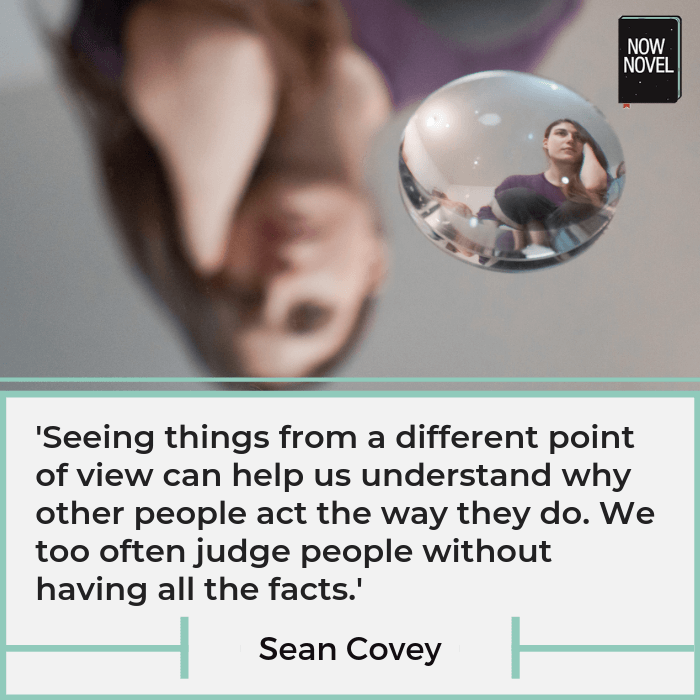Writing scene beginnings readers find compelling is a useful skill to develop. Here are 5 ways to write strong scene beginnings, with examples:
1. Start scenes with unusual events in motion
Scenes that begin with ‘business as usual’ can be fascinating in their own right, if we tell them in an interesting way. Yet many effective scenes begin with characters taking unusual actions.
What counts as an unusual action for a scene beginning? It could be:
- Activity that reads suspiciously (e.g. digging a deep pit out in the woods)
- Action that implies a departure from routine or surprising turn of events (e.g. ‘This morning, she skipped her 9 am tram to work’) – a turn of events that makes us ask ‘why?’
- An event that elicits wonder or surprise (for example ‘We were sitting on the roof sneaking gin on New Year’s Eve when we heard a bang that was definitely no firework’)
An ‘unusual’ event does not need to be exceptionally unusual. Consider this example from Kent Haruf’s Our Souls at Night (2015):
And then there was the day when Addie Moore made a call on Louis Waters. It was an evening in May just before full dark.
Kent Haruf, Our Souls at Night (2015), p. 3.
This scene beginning shows an out-of-the-ordinary (yet simple) event – one character visiting another whom they don’t usually call on.
The way Haruf begins his sentence mid-swing (‘And then…’) creates a sense of an event that has been some time in the making. The visit is presented as an incident that follows some kind of history, an ‘and’ rather than a true beginning. It ropes us in with this sense of a new turn of events that also has its own hinted at history.

2. Begin scenes with tone-building scene setting
Scene setting – creating a sense of the place where your scene will unfold – is an important skill. It’s a gift to be able to evoke a world that feels real.
Depending on the tone and genre of your story, you may wish to set the coming scene with a sense of suspense or menace, for example. Is there something a character doesn’t yet know they should? Is someone observing someone else who remains completely oblivious? Or is the environment itself menacing?
Margaret Atwood’s speculative fiction novel Oryx and Crake (2003) has running themes of the cost of environmental destruction. This scene beginning, opening her chapter ‘Flotsam’, creates a sense of a harmful environment turned against its inhabitants, creating menace:
On the white beach, ground-up coral and broken bones, a group of the children are walking. They must have been swimming, they’re still wet and glistening. They should be more careful: who knows what may infest the lagoon? But they’re unwary; unlike Snowman, who won’t dip a toe in there even at night, when the sun can’t get at him.
Margaret Atwood, Oryx and Crake (2003), p. 6
Atwood’s description of the menacing lagoon (and the wading children’s relative innocence) immediately conveys a sense of danger. We wonder what else might happen in the lagoon over the course of scenes to come.
When you begin a scene with describing place, zero in on what gives this place its character. Is it warm and inviting, or full of unknown terrors like Atwood’s lagoon? Unfurl place at the start of a scene so your reader has something to anchor the proceeding action to.
[Outline and organize scene summaries and add them to your outline as you go using Now Novel’s Scene Builder tool].
3. Give intriguing backstory leading into your next scene
The start of a scene, or its lead-in, is a good time to give a little character backstory that gives context.
The fourth chapter of Donna Tartt’s The Goldfinch (2013) begins with the narrator Theo sharing details about his mother’s arrival in New York, years before his own birth:
Three important things had happened to my mother after she arrived in New York on the bus from Kansas, friendless and practically penniless.
Donna Tartt, The Goldfinch (2013), p. 20.
This is more a scene transition than a scene beginning. But by sharing three important details from Theo’s mother’s past, Tartt gives context for the scenes that follow, for our brief encounters with Theo’s mother.
Context gives us something to anchor the following scene to – a frame of reference.
The details about Theo’s mother’s past (that she arrived in New York ‘friendless and practically penniless’) create an element of suspense, too, as we wonder how she survived under these tough conditions. Beginning a scene with backstory can thus be intriguing rather than boring. It’s all in the telling, how you narrate the past using mystery (e.g. the mysterious ‘three important things’ that happened to Theo’s mom) and suspense.
4. Switch to a new, interesting viewpoint
One way to start a scene with a change that grabs readers’ attention is to change viewpoint character and take your story along a temporary detour.
When a new main character has entered your story, shifting to their viewpoint for a chapter can take your story to new vistas, free of the constraints of the previous viewpoint character’s location, situation or past.
Gabriel Garcia Marquez does this beautifully in Love in the Time of Cholera (1985). An old suitor, Florentino Ariza, shows up unexpectedly at the wake for his former flame’s husband.
Marquez uses this to pivot from the widow Fermina Daza’s point of view (her shock at his arrival) to the suitor’s own experiences prior to their reunion.
We read how the widow, Fermina Daza, thinks more about Florentino than her recently deceased husband that night. The next chapter begins:
Florentino Ariza, on the other hand, had not stopped thinking of her for a single moment since Fermina Daza had rejected him out of hand after a long and troubled love affair fifty-one years, nine months, and four days ago.
Gabriel Garcia Marquez, Love in the Time of Cholera (1985), p. 53.
The way Marquez moves back and forth between different key players’ perspectives, scene to scene, gives a strong sense of how their views and opinions of shared events, and each other’s behaviour, differ. Opening a scene with a new viewpoint thus gives a chance to add another fascinating layer of perspective.

5. Introduce intriguing uncertainties
A large part of why we keep reading is to resolve the unease of not knowing.
When writing scene beginnings, think of ways you can make the route ahead intriguing in uncertainty. The ‘5 W’s’ which we often speak about here – who, what, why, where and when – are helpful. Who will appear in the scene? What will happen? Why? Where and when will it happen?
The opening of chapter two in Arundhati Roy’s The Ministry of Utmost Happiness (2017) describes the birth of an intersex baby. This creates immediate intriguing uncertainty.
She was the fourth of five children, born on a cold January night, by lamplight (power cut), in Shahjahanabad, the walled city of Delhi. Ahlam Baji, the midwife who delivered her and put her in her mother’s arms wrapped in two shawls, said ‘It’s a boy.’ Given the circumstances, her error was understandable.
Arundhati Roy, The Ministry of Utmost Happiness (2017), 7
In the scene that follows, Roy describes how the mother Jahanara Begum goes through several states of reaction. Roy thus takes us from an initial uncertainty (the infant having both female and male anatomy) to the process by which the mother plans her course of action:
Her sixth reaction was to clean herself up and resolve to tell nobody for the moment. Not even her husband. Her seventh reaction was to lie down next to Aftab and rest. Like the God of the Christians did, after he had made Heaven and Earth. Except in his case he rested after making sense of the world he had created, whereas Jahanara Begum rested after what she created had scrambled her sense of the world.
Roy, The Ministry of Utmost Happiness, p. 8.
When you begin a scene, think about what uncertainties you could create to build anticipation and suspense, too. What will take characters out of their states of comfort? Turns of events such as these force characters to make new, interesting choices that propel scenes (and your story) in new directions.
Need help developing your scenes and keeping them focused and compelling? Get constructive feedback on Now Novel from peers or work with a writing coach one-on-one.


One reply on “Grabbing attention with scene beginnings: 5 tips”
[…] More information: https://www.nownovel.com/blog/writing-scene-beginnings-grab-attention/ […]